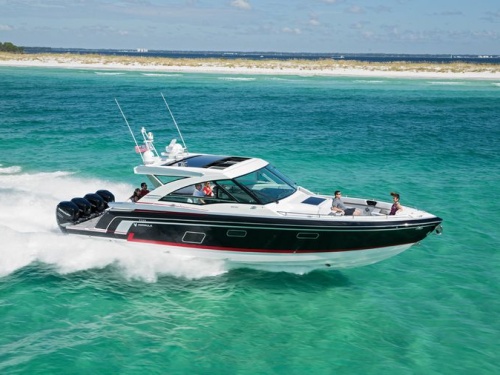Access More Boat Tests
Already have an account? Login
Formula 400 Super Sport Crossover (2019-)
4 x 350-hp Mercury Verado
Brief Summary
The Formula 400 Super Sport Crossover is the fifth introduction in the boatbuilder’s line of crossover boats that incorporate bow seating areas and overnight accommodations. She has a single-level main deck with four social areas and a counter area with a refrigerator and sink. Belowdecks, a dinette converts to a berth forward and there’s a crawl-in berth beneath the helm deck aft, a galley with microwave, and a wet head compartment.
Key Features
- Fas3Tech hull
- Bow area with tables that convert to a sun pad
- U-shaped cockpit lounge with transformative power-actuated table
- Quad 350-hp Mercury Verado outboards with Joystick
- Large hardtop with power sunroof
- Belowdecks salon with 6’5” (1.956 m) headroom
- Private head compartment
- Usable swim platform with side access and stainless reboarding ladder
- Rockford Fosgate stereo with 10 JL Audio speakers
- Mercury SmartCraft VesselView display
- LaunchPort digital switching system
- Painted hull with Axalta Chroma Premier basecoat and Imron clearcoat
- Electric windlass
Test Results
| RPM | MPH | Knots | GPH | MPG | NMPG | STAT. MILE | NM | dBa |
|---|---|---|---|---|---|---|---|---|
| 600 | 2.7 | 2.3 | 2.5 | 1.1 | 0.9 | 383 | 333.2 | 67 |
| 1000 | 5.7 | 5 | 4.5 | 1.3 | 1.1 | 456 | 396.5 | 68 |
| 1500 | 8.5 | 7.4 | 7.7 | 1.1 | 1 | 396 | 344.4 | 70 |
| 2000 | 9.9 | 8.6 | 13.9 | 0.7 | 0.6 | 255 | 221.7 | 74 |
| 2500 | 10.9 | 9.4 | 22.9 | 0.5 | 0.4 | 171 | 148.3 | 79 |
| 3000 | 17.1 | 14.9 | 31.9 | 0.5 | 0.5 | 193 | 167.8 | 84 |
| 3500 | 19.5 | 16.9 | 38.9 | 0.5 | 0.4 | 180 | 156.5 | 87 |
| 4000 | 25.3 | 22 | 42.8 | 0.6 | 0.5 | 213 | 184.9 | 87 |
| 4500 | 34.5 | 30 | 52.1 | 0.7 | 0.6 | 238 | 207.2 | 90 |
| 5000 | 42.9 | 37.3 | 63.7 | 0.7 | 0.6 | 242 | 210.8 | 91 |
| 5500 | 50.8 | 44.1 | 73.9 | 0.7 | 0.6 | 247 | 215.1 | 92 |
| 6000 | 55.7 | 48.4 | 89.4 | 0.6 | 0.5 | 224 | 194.8 | 93 |
| 6430 | 61.1 | 53.1 | 119.1 | 0.5 | 0.4 | 185 | 160.7 | 95 |

Specifications
| Length Overall |
40' 12.19 m |
|---|---|
| Beam |
12' 3.66 m |
| Dry Weight |
23,700 lbs. 10,750 kg |
| Tested Weight |
26,705 lbs. 12,113 kg |
| Draft |
40'' 1.02 m |
| Deadrise/Transom | 21-deg. |
| Max Headroom |
6' 5'' 1.96 m |
| Bridge Clearance |
13' 3'' 4.04 m (max) |
| Fuel Capacity |
400 gal. 1,514 L |
| Water Capacity |
56 gal. 212 L |
| Total Weight |
26,705 lbs. 12,113 kg |
Acceleration Times & Conditions
| Time to Plane | 4.7 sec. |
|---|---|
| 0 to 30 | 12.5 sec. |
| Ratio | 1.75:1 |
| Props | Rev 4 - 14 5/8 X 19 |
| Load | 3 persons, full fuel, no water, 50 lbs. of gear |
| Climate | 87 deg., 65 humid; wind: 5-10 mph; seas: 1-2 |
Engine Options
| Tested Engine |
4 x 350-hp Mercury Verado |
|---|---|
| Opt. Power |
4 x 300-hp Mercury Verado 4 x 350-hp Mercury Verado |
 Learn More
Learn More
Watch Our Video
Contents of Report
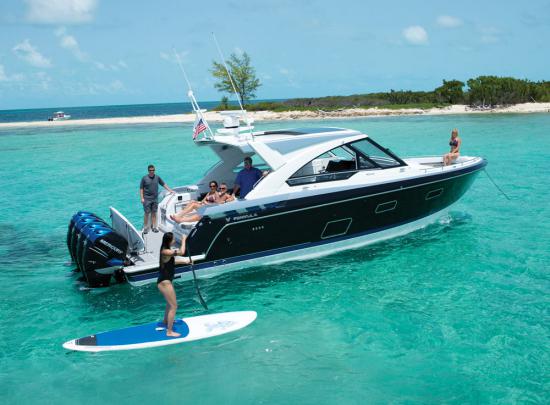
Mission
The Formula 400 Super Sport Crossover, otherwise known as the 400 SSC, is designed to offer flexibility to boaters who wish to invite large groups of friends aboard for a day of enjoying her invigorating performance, yet may also want to cruise offshore and to islands and spend occasional long weekends aboard. Her large swim platform has port and starboard launching points for watersports of any sort.
Overview
Quad 350-hp Mercury Verados (an upgrade from the standard 300-hp Verado outboards) add a range of electronic features to adjust efficiency and supercharged performance. Her large hardtop with integrated wrap-around windshield means everyone on board can benefit from the shade and protection from the elements as needed. Formula used its SmartZone design to place four main-deck social zones all on one level, eliminating steps that can pose a tripping hazard. A bow seating area and broad swim platform with side access add to the boat’s versatility for picnics and swim parties.

Distinguishing Features
- U-shaped cockpit seating area gathers guests and is served by a table on a power pedestal that allows it to drop flush to the deck – becoming the deck. Raise it to dining height or stop anywhere in between, including stopping at the appropriate level to add a filler cushion to create a large sun pad.
- Functional Swim Platform. Formula has pushed the engines aft to create usable deck space abaft the transom and in front of the engines to launch watersports.
- Quad Mercury Verado Outboards. Quad 300 Verados are standard, and 350 Verados are available.
- Joystick and active trim come standard.
- Bow seating area with forward-facing seats and a stowable two-piece table.
- Two-step Fas3Tech hull offers more speed and fuel efficiency and does not sacrifice handling.
- Hardtop with integrated windshield with sliding panel for bow access, as well as a power sunroof.
Performance Test
The Formula 400 Super Sport Crossover has a length overall of 40’ (12.19 m) and a beam of 12’ (3.65 m). With an empty weight of 23,700 lbs. (10,750 kg), 400 gallons (1,514 L) of fuel, no water, and three people on board, she had an estimated test weight of 26,705 lbs. (12,113 kg).

The 400 Super Sport Crossover was powered by four supercharged 350-hp Mercury Verado 2.6 L outboards with 1.75:1 gear ratios turning Rev 4 14-5/8” by 19” props. (See the BoatTEST review of this engine here.) We reached a top speed of 61.1 mph at 6430 rpm.
Best cruise was at 5500 rpm and 50.8 mph. It was at that speed that the 73.9 gph fuel burn translated into 0.7 mpg and a range of 247 statute miles (397.5 km).

Handling
The Formula 400 Super Sport Crossover has the high-speed handling we’ve come to expect from this builder, with a confidence-building inward lean to bank through hard turns at speed. When making sharp turns, just as with any express hardtop, the overhead will obscure sightlines aft – so always clear the space before making the turn. This was a lesson we remembered when testing the 400 Super Sport Crossover, especially when there’s a mosquito fleet of PWCs around.

For slow-speed maneuvering, the Mercury Joystick Piloting for Outboards (JPI) system makes light work of precise maneuvering as the outboards independently direct thrust proportional to the movement of the joystick. And the optional bow thruster helps when a strong current is running in a tight marina.


Features Inspection

The Helm
Formula has racing in her DNA and that extends to the helm, where a three-position helm seat serves a wide helm dash nestled abaft a full-height wraparound windshield. On the dash instrument panel and on the right-hand side control arm, there is a wealth of computing power that was beyond our imagination just 15 years ago. Formula has harnessed it to make controlling the 1400 horses on the stern and one of the most complex boats her size so easy, most anyone can handle this vessel with a little instruction.

The Helm Seats. They are made of high-quality weather resistant vinyl with a Pre-Fixx coating and Tenara UV resistant thread. Under the surface is multi density DriFast foam on Starlite XL synthetic marine substructure, which will never rot or soak up water. These comfortable seats each have their own flip-up bolster so each person can sit, stand or lean, as desired.
There is a bi-level, angled footrest positioned beneath the helm that allows for multiple combinations of sitting, standing, and leaning positions.

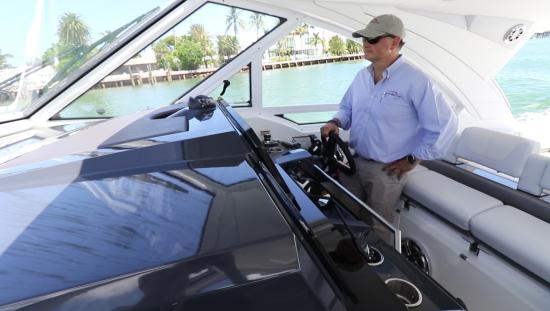

Straight ahead is the control station with two Raymarine Axiom 12 GPS widescreen color chartplotters with digital depth sounders. Much of the onboard electrical system is also controlled by the LaunchPort system, which uses digital switching and a touchscreen interface. Rocker switches to port of the wheel control electrical functions, which to some degree is a belt and suspenders approach. We like the redundancy as some people are still touch-screen shy.
Let’s tackle this high-tech helm, starting with the propulsion controls and move on to the electronic screens later.
Mercury Quad Digital Throttle and Shift Binnacle. The tilt of the binnacle on the angled shelf outboard of the helm is ergonomically correct, something that we don’t always see. Of course, it is all drive by wire. The left lever controls the port engines and the right one controls the starboard engines. In this way, the port or starboard engines can be handled differently when required. The engines are automatically synchronized.
Joysticks for Outboards (JPO) is pretty much a necessity with quad engines for most people, and Formula makes the JPO system standard equipment.(See our in-depth video and report on the Mercury JPO system here.)
This system also has Active Trim as standard. (See BoatTEST’s video and report here.) Suffice it to say that a light ring around the base of the joystick signals that the unit is engaged or not and the direction and intensity of the power being applied. In this way, if the boat does not respond with alacrity, a quick glance can confirm that it is engaged, and possibly more force should be applied to the joystick.
A bow thruster is optional, our test boat had one, and we recommend it for several reasons. First, in a tight marina with a strong cross current, it can be a welcome help for the engines at the other end trying to twist the boat against the current. Second, there are times when a quick nudge on the bow thruster toggle is simply faster than moving the bow by way of the engines at the stern. We would like to see the bow thruster toggle moved to the right of the wheel, near the joystick.

The Bennett Auto Trim Pro hydraulic trim tabs controls are placed between the joystick and the glass screen control. (We’d like to see that control moved from ahead of the binnacle to behind it, so we don’t have to reach over the sticks to get at it.) The Bennett trim tabs are 26” (66 cm) long and take a lot of power at high speeds. Formula has used this brand for years and has employed them for durability.


Mercury SmartCraft VesselView puts all engine-management functions on one screen for ease of use, and the Mercury Verado outboards have plenty of add-on features to dial in the efficiency and performance.

The LaunchPort is an intuitive interface with the electrical system, similar to the annunciator panel that some large yachts carry that’s schematic of the yacht with lights that show when pumps are running. While it uses the touchscreen on a Raymarine Axiom multifunction display very effectively to navigate and operate boat systems, it also can be operated by a remote iPad.

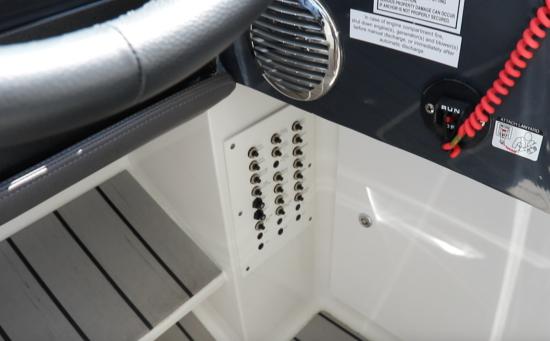
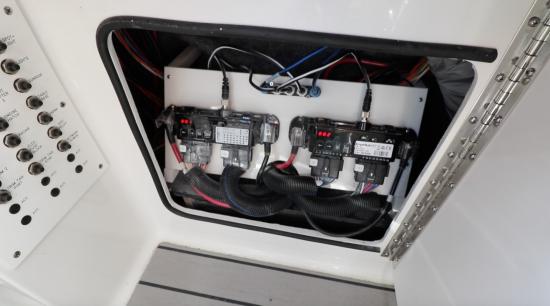
The locking glovebox has USB connections to plug in devices as well as card slots to connect cartography to the electronics array. There’s a tray for phones directly below.


Optional 18,000-BTU air conditioning in the cockpit can make hot days more bearable, with vents cooling the helm area, while quarterlight vents to port and starboard open on their forward end to funnel natural ventilation through the main deck area while running. In the console beneath the helm seats, there’s a sliding rack for an optional carry-on Yeti Tundra 35 cooler with pullout drawer.

A standard Rockford Fosgate stereo system is ready to crank the tunes, and has taken premium-class boats by storm the last couple of years. With 16 LED-illuminated JL Audio speakers throughout the cockpit, hardtop, swim platform, bow area, and belowdecks, the Formula 400 Super Sport Crossover is a virtual sound stage that could keep the whole harbor swinging to the music. There are remote control heads, too, in case anyone wants a change in tempo.
The 400 Super Sport Crossover is “subscription-ready” for Sirius Satellite radio.


The Hardtop
The hardtop helps bring together the design by being so fully integrated and sheltering so much of the deck space from the elements. The hardtop spans the full beam of the boat and is integrated with the windshield frame, helping reduce the impact of the wind from the boat’s underway speed, as well as spray and precipitation, should conditions deteriorate.
There’s 6’5” (1.95 m) overhead height beneath the hardtop and it also has an integrated radar arch aft when the antennas are mounted. There’s a power sunroof over the helm area.


A standard power sunroof is controlled from the helm dash rocker or from the Launchport touchscreen control integrated into the helm multifunction display. The system controls all of the electrical digital switching, and can even be accessed through an available iPad.





Cockpit Area
Here’s where we see what Formula calls its “SmartZone design” – there is one level from the swim platform all the way to the bow seating with no steps up or down thus eliminating a trip hazard.

There’s a U-shaped lounge abaft the helm’s three-wide helm seat. Here we find one clever aspect of the boat. At the touch of a button, the deck rises up to create the foundation for a large sun pad, and raising it still farther it becomes a table for cocktails or lunch.

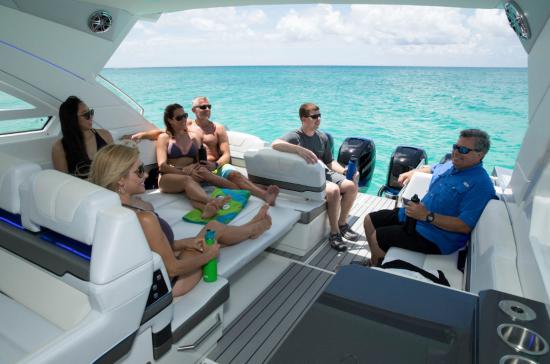



A flatscreen TV mounts to a receiver in the counter of the al fresco galley console. The plugs and jacks for it are in the aft-facing backrest. The TV can be stowed securely, and this dedicated locker.




A fore-and-aft bench seat is positioned on the port side, opposite the U-shaped lounge, making it easy to include two more people in the conversation. The bench backs up to a padded bolster, which has cutouts where grab handles and beverage holders are placed with no loss to the comfort of the seat. This seat can also be used for lounging in the shade of the hardtop, facing either forward or aft.
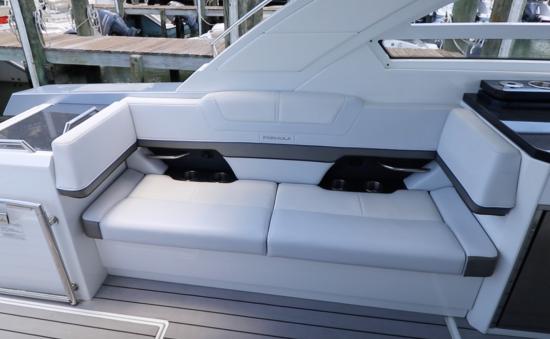
The al fresco galley console is positioned on the port side forward of the portside cockpit lounge. It’s a good working height at 34½” (87.63 cm) and is topped with Corian. The sink has a designer-style faucet fixture, a hideaway cover, and an angled shape to optimize counter space.
Three drawers in the console offer stowage for utensils and kitchen gear, or whatever else is needed close at hand. The refrigerator keeps drinks cold, and there’s a drawer for additional stowage above. A locker in the cabinet has dedicated trash can stowage and a paper towel holder.
We like the stainless steel handhold for those moving fore and aft in a seaway, and matches the oblique angle of the countertop. Dedicated blender stowage is next to the fire extinguisher.
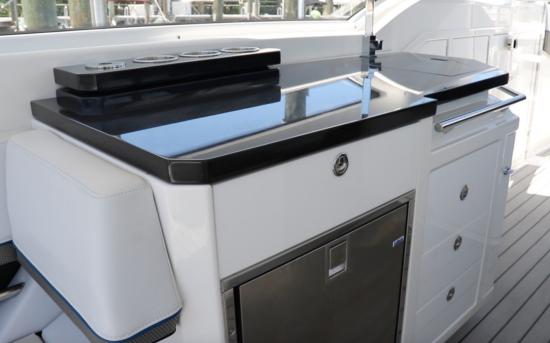


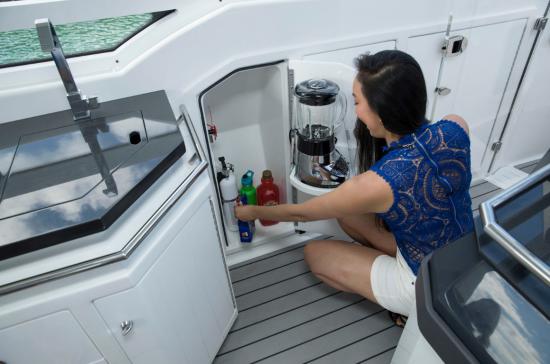



The Bow Area
As we move to the bow, we noticed that a big part of what makes this design work so well both above and belowdecks is the 21” (53.34 cm) wide portside walkway to the bow. Placing this walkway all the way to the port side opens up the belowdecks accommodations.
A sliding windshield section opens up to the foredeck area. We like this much better than the windshields which are on hinges and have to be swung over and are often unwieldy. A clear acrylic air dam takes care of the lower half of the walkway, blocking the wind on inclement days and swinging outboard on hinges when unencumbered bow access is needed.

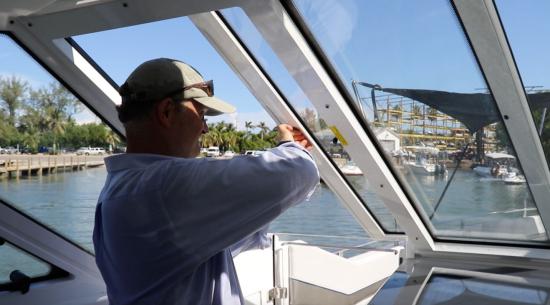


The bow seating wraps around the open bowrider area forward of the helm, starting with a bench aft, curling along the starboard bow, crossing the bow forward, and creating a port-side bench. The seats use padded bolsters as backrests on the starboard side and forward, while the aft bench backs up to the bulkhead that defines the belowdecks accommodations.
The bolsters have cutouts beneath that create room to accommodate speakers, beverage holders, grab handles, and USB device-charging ports. The upholstery is finished to a high Formula standard, one of the best in the boating industry.
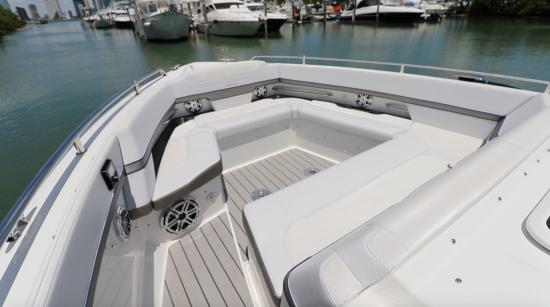


A pair of tables really enhances the flexibility of the bow seating area. Owners can opt to use one table or both at any given time. These Corian tables come with short pedestals, too, which position them at just the right height to take an available filler cushion and create a sun pad area.


The sunshade awning is a good idea and has been very long in coming to bowriders. Formula’s awning system has poles that mount in the tops of four dedicated bow rail stanchions. The fabric sunshade stretches between the four poles. Those stanchions have plugs that use a detent ball to keep them in place when the sun shade is stowed, and, when it’s in use, the stanchion plugs have their own spot so they don’t get lost.
Remote control for the stereo and plenty of speakers make the bow area a lounging paradise beneath the sunshade, where it’s sure to be breezy at anchor.


Foredeck
The foredeck has a hatch that conceals the standard electric windlass to manage the anchor, which sits on a through-the-stem pulpit. As we have mentioned before, we would like to see a larger opening or an alternative opening to the rode locker. The reason is that when the bow rises and falls the chain can get tumbled around as if it were in a washing machine – and become very tangled. It takes two hands and can take lots of work to set the chain to rights.
The foredeck is covered with nonskid and has 8” (20.32 cm) mooring cleats to either side.



Lazarette
Beneath the portside walkway through the transom is a hatch offering quick access to a large lazarette housing lots of key equipment. Better access is thanks to electric rams that raise the entire aft seat and sun pad. The space conceals a sea chest, batteries, inverters, battery chargers, fuel filters, diamond-plate pattern composite decking, the genset, and a fixed fire extinguisher system.



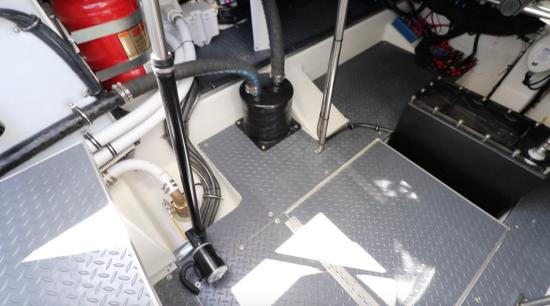
The Stern
Abaft the cockpit we find an aft lounging area with a large locker beneath for stowing fenders and the like. The backrest of this aft lounge is shared with the aft section of the U-shaped cockpit dinette, and folds forward to create a true aft-facing, double-wide chaise for use at anchor.
On the port side of the swim platform is a console that houses an optional electric grill beneath a countertop that when open serves double duty as a food prep counter. A hinged silicone cover protects the upholstery when grilling and goes over the grill when not in use.



The Swim Platform
The boating industry knew that it had to find a way to give boaters access to a functional swim platform on an outboard-powered boat, but were slow to figure out how to do it. Formula was the first to break the code: Move the engines further aft so that the swim platform could emerge port and starboard along the sides of the boat instead of behind it.
By putting the swim platform forward of the outboards at 11’3” by 4’7” (3.42 m x 1.39 m), and designing it to create enough deck space for bathers, scuba divers, wakeboarders, and skiers to launch themselves to either side, the problem was solved. A second benefit is that it gives people an easy place to access the boat.
An available pair of brackets for standup paddleboards mount in receivers in the deck. There are two sets of receivers because the SUPs need to move forward to tilt the outboards.


To either side of the swim platform are unobtrusive slots where a welded-steel boarding ladder mounts. Pull-up cleats in the corners of the platform are an unobtrusive way to improve mooring options. There’s a glass and stainless steel gate that can close off the 24” (60.96 cm) wide transom walkway.


In the same console as the electric grill, there’s a water hookup as well as a pair of 30-amp shore power connections and a TV hookup. Under a gasketed lid are the battery switches and a locker to stow shore power cords, as well as the shore power breakers that are handy right inside there as well.


Automated Outboard Freshwater Flushing System
With four outboards, flushing them one at a time can be a time-consuming process. Formula fit the 400 Super Sport Crossover with an optional automated flushing system connected to all four outboards, and they should be flushed after each use even in freshwater. The operator simply hooks up a dock hose and hits the button: the system takes the engines through the complete flushing process.

Accommodations
In the helm console, a three-step companionway leads to the lower deck. The step treads are solid wood and mounted to a robust stainless steel support. The overhead is 6’4½” (1.94 m) and the space is lit with LEDs and also blue LED accents/courtesy lights.
A forward U-shaped lounge is forward around a pedestal table. The dinette table is as large as possible to maximize the dining possibilities, and this makes a tight squeeze getting by on the starboard side. But the table swivels, making passage possible.



Also along the port side, is a refrigerator, some lockers and drawers, and a window for light that opens to the bow walkway for ventilation. There’s a column on the port bulkhead that serves as a belowdecks command center, with the optional magnetic mount and induction charging connector for the Launchport iPad, as well as air conditioning and stereo controls.


A microwave and flatscreen TV are positioned to starboard. There’s a Corian counter with a covered sink. The locker beneath has the manual control for the 56-gallon (212 L) fresh water system, with a tank gauge, as well as dedicated stowage for a trash can and a roll of paper towels.

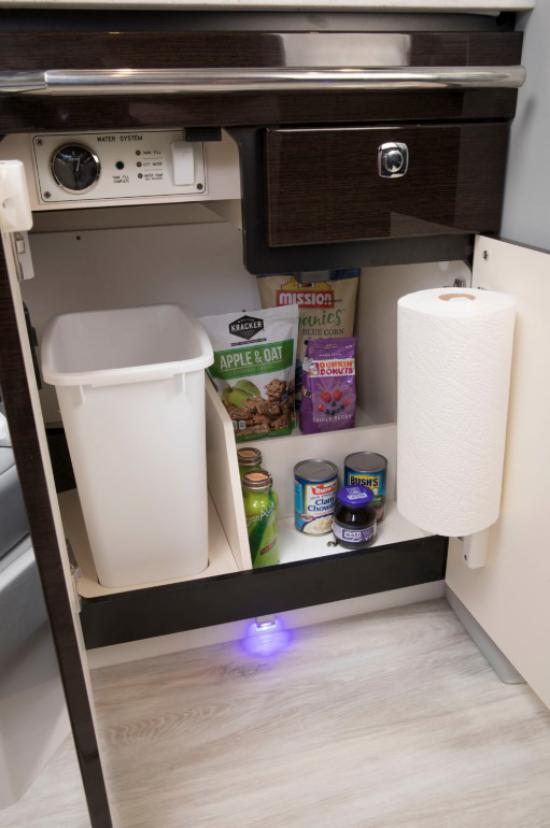
To create a convertible berth, the dinette has a pedestal table that can be lowered and accept a filler cushion to create a sleeping berth. The forward backrest on the dinette flips up to allow additional legroom.

The amidships cabin/berth is of the crawl-in variety beneath the helm deck above with 28” (71.12 cm) headroom and its own starboard hull side window for natural light and also a private TV. There are electrical plugs and device charging USB ports, and a carbon monoxide alarm as well as another mounting and charging point for the LaunchPort iPad.

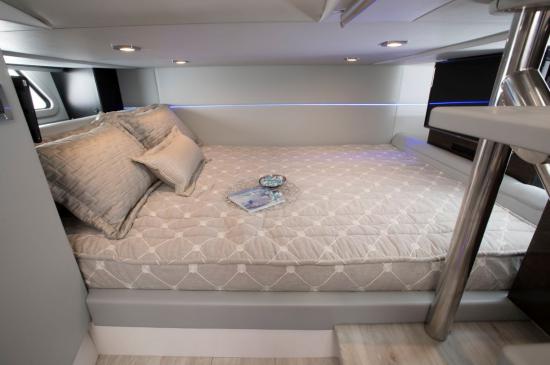
Head Compartment
The wet head has a 6’2½” (1.89 m) overhead height. There is a wand shower and a porcelain toilet. The counter is again Corian. There’s also overhead stowage, and an exhaust fan.

Hull Inspection
On our test day, the Formula 400 Super Sport Crossover was in rack storage, so we were able to get a good look at her running surface prior to our test. The hull on the 400 Super Sport Crossover has a sharp entry to help prevent pounding when it gets rough, and the bottom warps to 21-degrees of deadrise at the transom, 3-degrees less than the optimal 24-degree deep-V deadrise.
This is a calculated compromise between riding comfort and speed that designer John Adams and Formula over the years have decided is the optimum place to be.

John Adams has designed Formula boats for more than 45 years and he broke the code years ago on the design shapes and parameters that make the best hull for Formula boat owners. More recently, he has added steps in the hull for the Formula 400 Super Sport Crossover Fas3Tech.



Steps for Speed and Efficiency. The forward step is 3 ½” (8.89 cm) deep, and the strakes are 4” (10.16 cm) wide and the chine is 4 ½” (11.43 cm) wide. The aft step is 4 ½” (11.43 cm) deep and from there aft, it’s just the uninterrupted surface of the hull to the transom. The steps introduce air to the running surface to help break the water’s grip on the hull, reducing the drag of the wetted surface to make the boat go faster and burn less fuel.
Over the years, BoatTEST has conducted enough tests on boats with and without strakes to demonstrate that stepped hulls, if properly executed, do increase speed and efficiency. It is, in fact, a very old nautical design concept that goes back to the early days of the 20th century.
What Strakes Do. The strakes and chines provide horizontal surfaces that provide lift to help the boat jump on plane, improve fuel efficiency, and reduce the rolling moment somewhat. The chine is 5 ½” (13.97 cm) wide aft and then narrow as they move forward. Likewise, the strakes are wider aft and narrow going forward.
The hull design – the amount of bottom deadrise at each section of the hull, the position and width of the strakes and chine, and the details of the steps – are the “secret sauce” of John Adams and Formula. Their hulls are invariably excellent performers.
Trim Tabs. The 400 Super Sport Crossover has Bennett hydraulic tabs that are 26” (66.04 cm) long.

Construction
Formula has been building boats for over 50 years. It started life as an offshore powerboat racing brand, and to survive the punishment of driving a fiberglass hull over the water and waves at 70+ mph, the hulls had to be tough. The company has continued building its boats ruggedly down through the decades, and we have never heard of a hull failure of a Formula boat.
As far as other aspects of the build go, the company consistently uses best practices and is usually one of the first builders to adopt new technology.
Formula Flex Program
FormulaFlex™ is a program by Formula Boats that offers individual personalization in key areas such as graphics, upholstery, and electronics. FormulaFlex changes are all available at no cost to the customer, and if something is desired beyond those offerings, FormulaFlex MyWay™ allows for further upgrades.
See our video on the FormulaFlex program here.

Formula Hullsides Paint
As we mention in most of our reports on Formula boats, this builder is one of only a very few that provide the option of painting their hulls. The reason is that it is a difficult, expensive, and labor intensive process to do it right. Formula uses Axalta Chroma Premier basecoat, which is the same as used on luxury automobiles. That is covered with Imron Elite clearcoat. Formula has five dedicated paint booths, the only builder in the industry that we know of that has more than one.
The surface is then buffed, compounded, and buffed again, for many hours by a team of specialists. More hours are actually spent on the finishing than on the painting itself.
See our video on the Formula painting process here.

Warranty
Formula offers a transferrable 5-year “Formula Guard” Limited Protection program that pretty much covers all components on the boat from stem to transom. Read the warranty fine print for exclusions and there are some, but it is generally considered to be one of the best warranty programs in the industry. The outboards carry their own 3-year warranty.
- 10 years hull and deck structure
- 5 years equipment and accessories not manufactured by Formula boats
- 2 years painted graphics and clearcoat finishes
- 2 years gelcoat finishes
- 2 years canvas manufactured by Formula
- 1-year materials and workmanship
Optional Equipment to Consider
- Hullsides paint
- Auto outboard flushing
- Bow thruster
- VHF radio, antenna
- Yeti Tundra 35 with drawer
- SureShade electric awning
- iPad LaunchPort control
- 18,000-BTU cockpit A/C
- Central vacuum sweepe
- Aft cockpit electric grill
- Bow sunshade
Price
Visit here for up-to-date pricing.
Observations
The Formula 400 Super Sport Crossover is only the fourth outboard boat produced by Formula in the last 45 years. To introduce something that had what every other company is offering would be a waste of dock space in their eyes – after all, this company has a dedicated following of performance-boating enthusiasts who want only the best and expect a boat to be functional as well as fast, strong, and very attractive. It is a tall order.
But Formula has met that tall order for practical innovation. A few years ago it embraced the crossover concept and created the best in class designs. Now, it has married that to outboard power and kept sterndrive on-deck utility.


